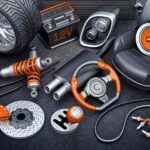Maintaining a vehicle requires not only regular service but also choosing the right components during replacements. As cars become more advanced in their engineering, electronics, and materials, the demand for high-quality, compatible parts continues to grow. One of the most critical decisions a vehicle owner can make is to opt for original car parts instead of generic alternatives.
The use of OEM (original equipment manufacturer) parts ensures not just compatibility, but also performance, durability, and safety. This is particularly relevant for premium manufacturers such as BMW and Audi, where mechanical precision and system integration are core to their identity.
Explore the full catalog of original car parts
Understanding the Role of OEM Parts
Original parts are manufactured by the same companies that produced the components installed in the vehicle during assembly. These parts are tested under strict conditions and meet manufacturer standards for fit and function. They are designed to work seamlessly with all other systems in the car.
In contrast, aftermarket parts are built by third parties and often cater to multiple models or brands. As a result, tolerances can vary, and materials may not meet the same quality benchmarks. While cheaper, aftermarket parts can introduce mechanical issues, shorten the lifespan of related components, or affect vehicle safety systems.
For vehicles with complex internal systems, such as Audi or BMW, avoiding deviations from original specifications is especially important.
Why BMW Owners Should Prioritize OEM Parts
BMW is known for its balance of power, engineering accuracy, and driving dynamics. This performance is supported by finely tuned systems that are interconnected—from the drivetrain to the electronic control units. Even a minor deviation from OEM standards can disrupt this balance.
Whether it’s an oil filter, brake pad, or a component of the suspension system, BMW parts should always be sourced from reliable, original channels. Not only does this prevent mechanical incompatibility, but it also helps preserve fuel efficiency and driver safety over time.
View OEM parts dedicated to your car model here: BMW original parts
In some cases, use of aftermarket alternatives may even void certain manufacturer warranties, especially for newer models still under service agreements.
Audi Vehicles and the Need for Part Precision
Audi’s reputation is built on a combination of innovation, technology, and quality. From virtual cockpit displays to quattro all-wheel-drive systems, these cars rely on integrated hardware and software to function correctly.
Using original parts ensures that replacement components interact properly with existing systems. For example, a genuine control unit will maintain proper communication with onboard electronics, whereas an aftermarket one might lead to diagnostic errors or system failures.
Maintaining consistency with the vehicle’s design architecture not only preserves its functionality but also its resale value and legal roadworthiness.
Long-Term Implications of Non-Original Components
The initial cost difference between original and aftermarket parts may seem significant, but it’s important to consider long-term consequences. Cheaper parts may wear out faster or cause collateral damage to other systems. A poorly manufactured suspension component, for example, could affect steering geometry or tire wear patterns. Similarly, incompatible sensors might disrupt engine management or safety alerts.
In the long run, the cost of fixing these secondary issues can far exceed the price of choosing OEM from the start.
Moreover, original parts contribute to better service documentation. When maintenance records show consistent use of original parts, the vehicle is more attractive to future buyers, who can trust in its service history.
The Supply of Genuine Car Parts Online
Digital access to OEM components has improved significantly. Many platforms, like 0parts, specialize in connecting customers directly to certified parts for a wide range of brands. Users can now search by vehicle model, part category, or manufacturer number, eliminating much of the guesswork that once came with online car maintenance.
0parts, in particular, focuses on supplying components only from original manufacturers, ensuring that both individual car owners and professional workshops can maintain quality across all repairs.
Compatibility, Performance, and Safety
Ultimately, the choice to use original car parts is rooted in three key principles:
- Compatibility: OEM parts are built specifically for your car’s make, model, and variant, reducing the chance of installation issues.
- Performance: The car continues to perform as it was designed—maintaining power, efficiency, and comfort.
- Safety: Certified parts meet regulatory safety standards, which may not be guaranteed with third-party alternatives.
Drivers of premium brands such as BMW and Audi benefit even more from this consistency, as their cars rely heavily on engineered integration and specialized components.
Conclusion
For long-term vehicle reliability and performance, using original parts is a decision that supports both short-term repairs and the vehicle’s future condition. Especially for technically advanced vehicles like BMWs and Audis, maintaining the original engineering integrity is essential.
Choosing original car parts minimizes risk, maximizes value, and preserves the core characteristics that define quality automotive design. Whether you’re replacing a brake pad or a central control unit, OEM parts remain the most responsible and reliable choice.








